Fast Reroute Mechanism for Satellite Networks Based on Segment Routing and Dual Timers Switching
Abstract
1. Introduction
2. Related Work
3. Design and Implementation of Fast Rerouting Scheme Based on Segment Routing and Dual Timers Switching
3.1. Overview of the SRDT-FRR Scheme
3.1.1. Scheme Modeling
3.1.2. Backup Path Design
| Algorithm 1 Global backup path calculation and activation |
|
3.2. Node Behavior Design
3.2.1. PLR Node Behavior
| Algorithm 2 Backup path activation and deactivation with dual timers |
|
3.2.2. Intermediate Nodes Behavior
3.2.3. Endpoint Behavior
4. Performance Evaluation
4.1. Simulation Setup
- SS-FRR Scheme: This scheme integrates segment routing, enabling satellites with greater computational resources to autonomously generate backup paths without relying on ground controllers. This reduces the interaction delay associated with centralized routing.
- Backup Path-based Link-State Routing Fault Detection Mechanism (BP-LSRFD): This mechanism detects faults within 3 s of occurrence and swiftly switches to backup paths.
- Backup Path-based BFD Detection (BP-BFD): This mechanism detects faults within 90 ms and promptly switches to backup paths.
- Link-State Routing Fault Detection Mechanism(LSRFD): This mechanism detects faults within 3 s, recalculates routes, and floods fault information across the network.
- Fault scenario a: Three random stable faults (5 s each). This scenario tests the fault recovery capability of the SRDT-FRR scheme under stable faults;
- Fault scenario b: Three random transient faults (500 ms each). This scenario evaluates the low switching overhead of the SRDT-FRR scheme during transient faults;
- Fault scenario c: Mixed faults (three 5 s stable faults and three 500 ms transient faults). This scenario assesses the scheme’s sensitivity to transient faults, demonstrating its ability to promptly detect and recover from such faults, reducing the routing interruption time.
4.2. Simulation Results
5. Conclusions
Author Contributions
Funding
Institutional Review Board Statement
Informed Consent Statement
Data Availability Statement
Conflicts of Interest
Abbreviations
| LEO | Low-Earth-Orbit |
| ISLs | Inter-Satellite Links |
| FRR | Fast Reroute |
| SR | Segment Routing |
| PLR | Point of Local Repair |
References
- Huber, S.; Younis, M.; Krieger, G.; Moreira, A.; Wiesbeck, W. A Reflector Antenna Concept Robust Against Feed Failures for Satellite Communications. IEEE Trans. Antennas Propag. 2015, 63, 1218–1224. [Google Scholar] [CrossRef]
- Zhao, G.; Kang, Z.; Huang, Y.; Wu, S. A Routing Optimization Method for LEO Satellite Networks with Stochastic Link Failure. Aerospace 2022, 9, 322. [Google Scholar] [CrossRef]
- Xu, H.; Shi, Z.; Liu, M.; Zhang, N.; Yan, Y.; Han, G. Link-State Aware Hybrid Routing in the Terrestrial–Satellite Integrated Network. Sensors 2022, 22, 9124. [Google Scholar] [CrossRef] [PubMed]
- Zhou, Y.; Chen, H.; Dou, Z. MOLM: Alleviating Congestion through Multi-Objective Simulated Annealing-Based Load Balancing Routing in LEO Satellite Networks. Future Int. 2024, 16, 109. [Google Scholar] [CrossRef]
- Miao, J.; Wang, P.; Yin, H.; Chen, N.; Wang, X. A Multi-Attribute Decision Handover Scheme for LEO Mobile Satellite Networks. In Proceedings of the 2019 IEEE 5th International Conference on Computer and Communications (ICCC), Chengdu, China, 6–9 December 2019; pp. 938–942. [Google Scholar]
- Lai, X.; Zhao, Y.; Jing, Y.; Wang, H.; Wang, W.; Zhang, J. Fast Routing Algorithm Based on Topology Pruning in Mega Satellite Optical Networks. In Proceedings of the 2023 21st International Conference on Optical Communications and Networks (ICOCN), Qufu, China, 31 July 2023; pp. 1–3. [Google Scholar]
- Chen, X.; Chen, Z.; Chang, X.; Ji, T.; Wu, Z.; Li, C. Fast Reroute Algorithms for Satellite Network With Segment Routing. IEEE Access 2023, 11, 133509–133520. [Google Scholar] [CrossRef]
- Zhang, X.; Cheng, Z.; Lin, R.; He, L.; Yu, S.; Luo, H. Local Fast Reroute With Flow Aggregation in Software Defined Networks. IEEE Commun. Lett. 2017, 21, 785–788. [Google Scholar] [CrossRef]
- Papan, J.; Segec, P.; Dobrota, J.; Koncz, L.; Yeremenko, O.; Lemeshko, O.; Yevdokymenko, M. Review of Fast ReRoute Solutions. In Proceedings of the 2020 18th International Conference on Emerging eLearning Technologies and Applications (ICETA), Košice, Slovenia, 12 November 2020; pp. 498–504. [Google Scholar]
- Chiesa, M.; Sedar, R.; Antichi, G.; Borokhovich, M.; Kamisinski, A.; Nikolaidis, G.; Schmid, S. Fast ReRoute on Programmable Switches. IEEE ACM Trans. Netw. 2021, 29, 637–650. [Google Scholar] [CrossRef]
- Lemeshko, O.; Arous, K. Fast ReRoute Model for Different Backup Schemes in MPLS-Network. In Proceedings of the 2014 First International Scientific-Practical Conference Problems of Infocommunications Science and Technology, Kharkov, Ukraine, 14–17 October 2014; pp. 39–41. [Google Scholar]
- Xu, W.; Li, X.; Huang, S. Shared Backup Path Protection for Satellite Ground Laser Link. In Proceedings of the International Conference on Frontiers of Electronics, Information and Computation Technologies, Changsha, China, 21 May 2021; pp. 1–6. [Google Scholar]
- Pan, T.; Huang, T.; Li, X.; Chen, Y.; Xue, W.; Liu, Y. OPSPF: Orbit Prediction Shortest Path First Routing for Resilient LEO Satellite Networks. In Proceedings of the ICC 2019—2019 IEEE International Conference on Communications (ICC), Shanghai, China, 9–13 May 2019; pp. 1–6. [Google Scholar]
- Atlas, A.; Zinin, A. Basic Specification for IP Fast Reroute: Loop-Free Alternates. In Document RFC 5286. 2008. Available online: https://www.rfc-editor.org/rfc/rfc5286.html (accessed on 1 March 2025).
- Hegde, S.; Bowers, C.; Gredler, H.; Litkowski, S. Remote-LFA Node Protection and Manageability. In Document RFC 8102. 2017. Available online: https://www.rfc-editor.org/rfc/rfc8102.html (accessed on 1 March 2025).
- Suzuki, K. An Efficient Calculation for TI-LFA Rerouting Path. IEICE Trans. Commun. 2022, 105, 196–204. [Google Scholar] [CrossRef]
- Zhang, S.; Li, X.; Yeung, K.L. Segment Routing for Traffic Engineering and Effective Recovery in Low-Earth Orbit Satellite Constellations. Digit. Commun. Netw. 2024, 10, 706–715. [Google Scholar] [CrossRef]
- Zhao, Y.; Wu, W.; Ning, X.; Tang, Y.; Li, S.; Qin, C.; Liu, J. STSR: A Satellite-Tailored Segment Routing Method for Efficient Space Communication. In Proceedings of the 2024 IEEE Wireless Communications and Networking Conference (WCNC), Dubai, United Arab Emirates, 21 April 2024; pp. 1–6. [Google Scholar]
- Bai, W.; Yang, H.; Tong, J.; Qin, Z.; Lyu, R. SVector Segment Routing for Large-Scale Multilayer Satellite Network. J. Commun. Inf. Netw. 2023, 8, 24–36. [Google Scholar] [CrossRef]
- Liu, Q.; Wang, D.; Pan, C. Rerouting strategy for satellite MPLS networks based on priority mechanisms. Comput. Simul. 2015, 32, 57–61. [Google Scholar]
- Filsfils, C.; Previdi, S.; Ginsberg, L.; Decraene, B.; Litkowski, S.; Shakir, R. Segment Routing Architecture. In Document RFC 8402. 2018. Available online: https://www.rfc-editor.org/rfc/rfc8402#:~:text=Segment%20Routing%20%28SR%29%20leverages%20the%20source%20routing%20paradigm.,SR%20node%20or%20global%20within%20an%20SR%20domain (accessed on 1 March 2025).
- Yan, F.; Luo, H.; Zhang, S.; Wang, Z.; Lian, P. A comparative study of IP-based and ICN-based link-state routing protocols in LEO satellite networks. Peer-to-Peer Netw. Appl. 2023, 16, 3032–3046. [Google Scholar] [CrossRef]
- Zhang, Z.; Zhao, K.; Li, W.; Fang, Y. Fast Recovery from Multiple Link Failures in LEO Satellite Networks. In Proceedings of the 2023 IEEE 34th Annual International Symposium on Personal, Indoor and Mobile Radio Communications (PIMRC), Toronto, ON, Canada, 5 September 2023; pp. 1–6. [Google Scholar]
- Zhou, R.; Zhang, Q.; Tao, Y.; Shen, Y.; Zhang, W.; Tian, F.; Tian, Q.; Qian, J. Intelligent Multipath Backup Ant Colony Routing Algorithm of Satellite Network Based on Betweenness Centrality. In Proceedings of the 2020 IEEE Computing, Communications and IoT Applications (ComComAp), Beijing, China, 20 December 2020; pp. 1–5. [Google Scholar]

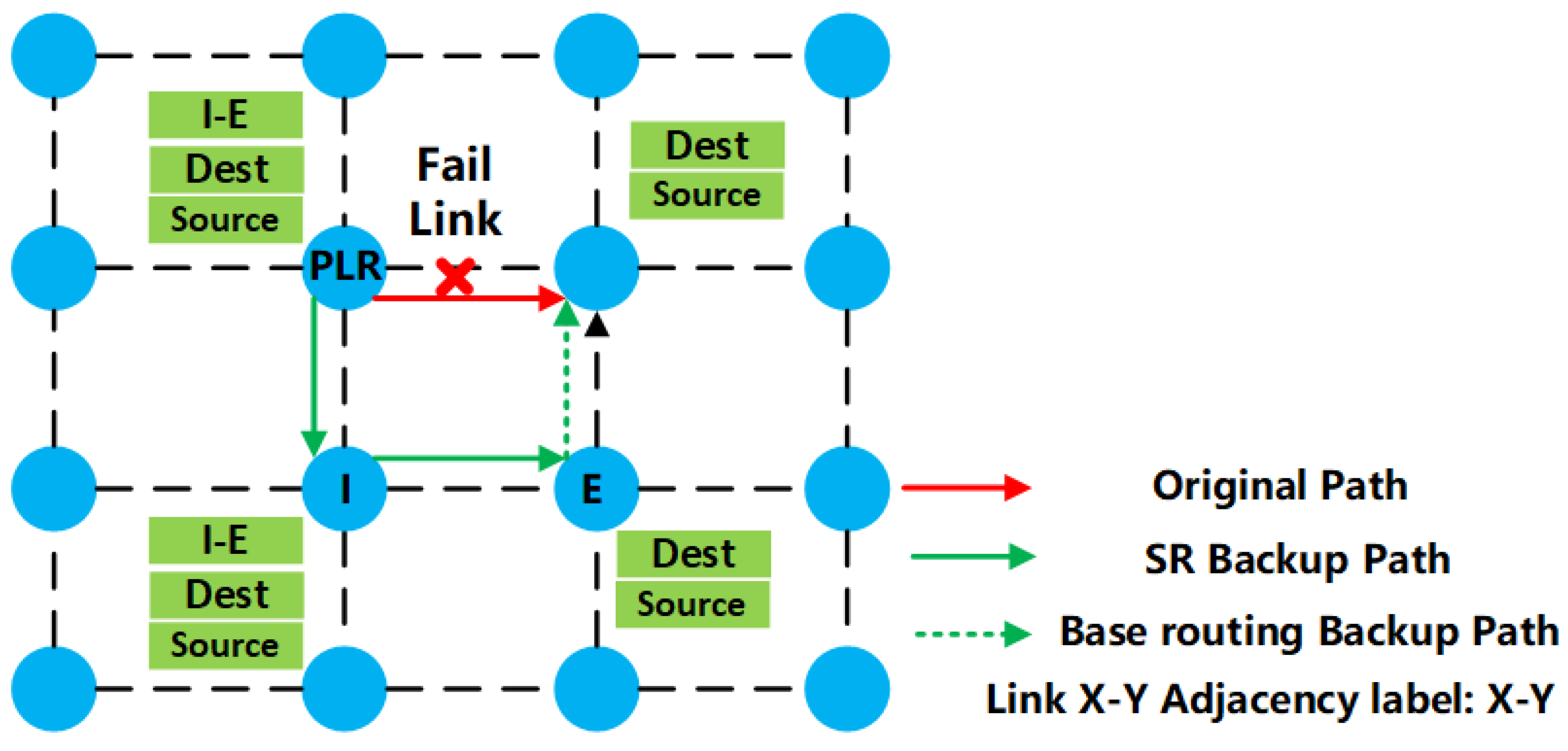



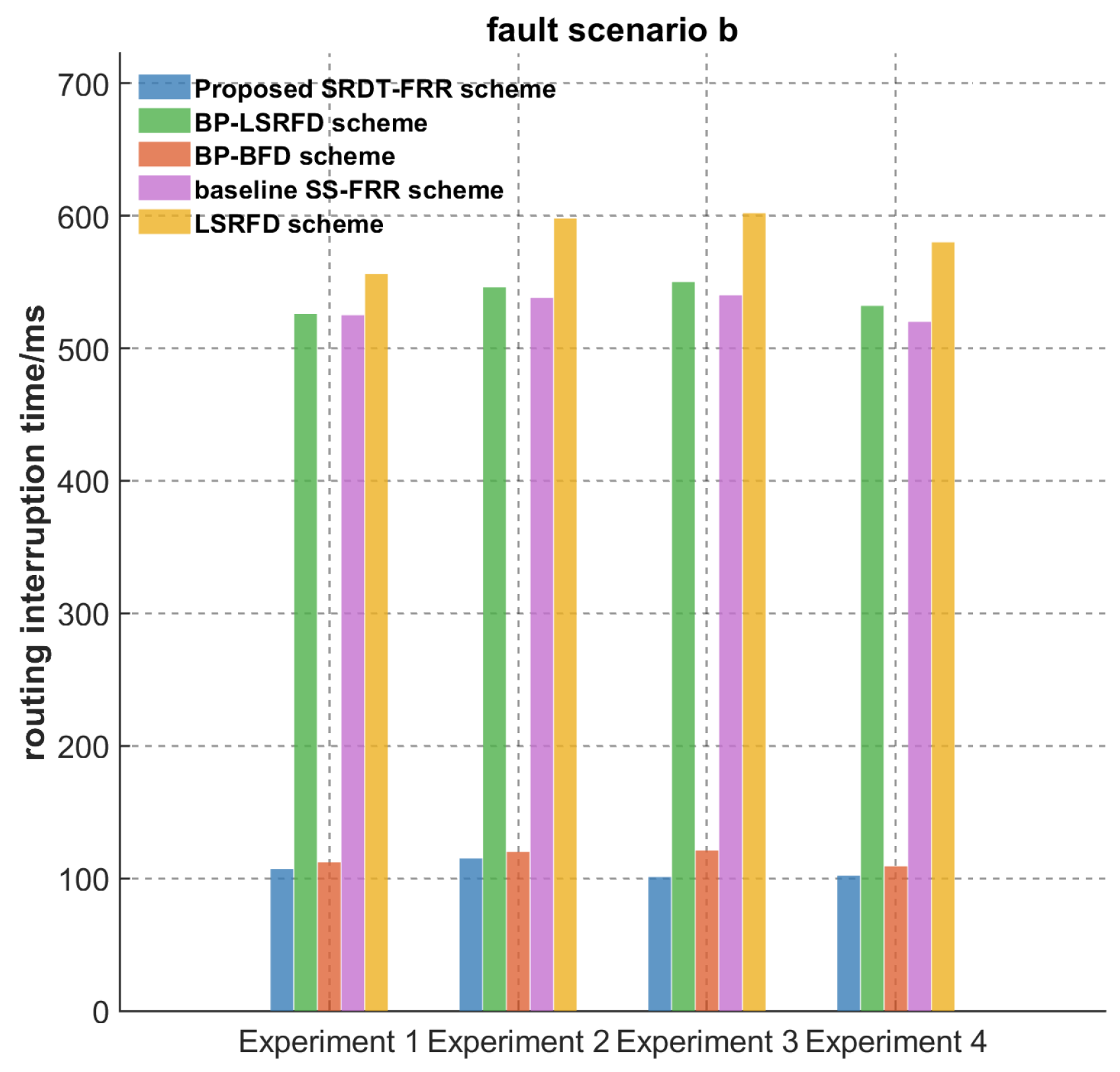
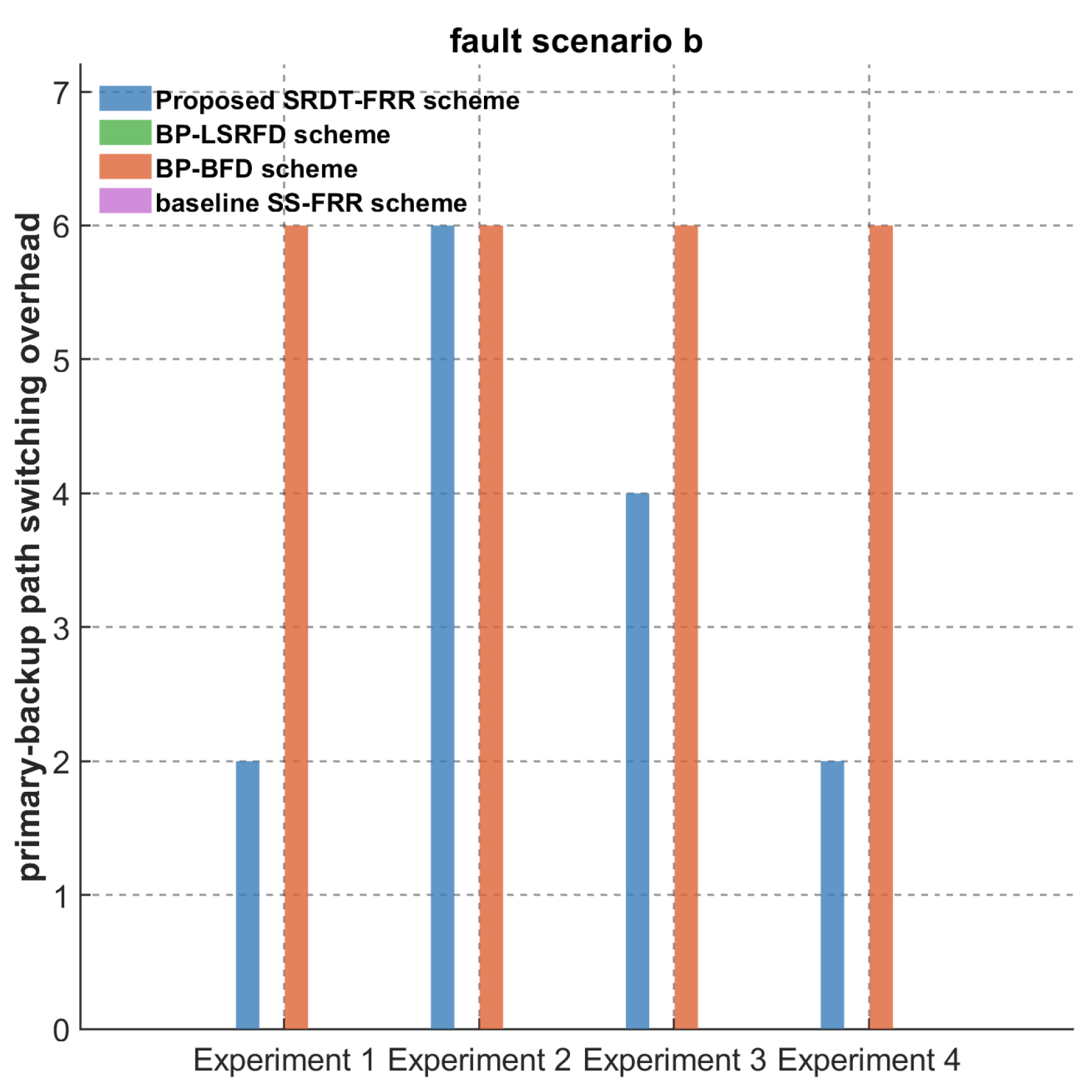
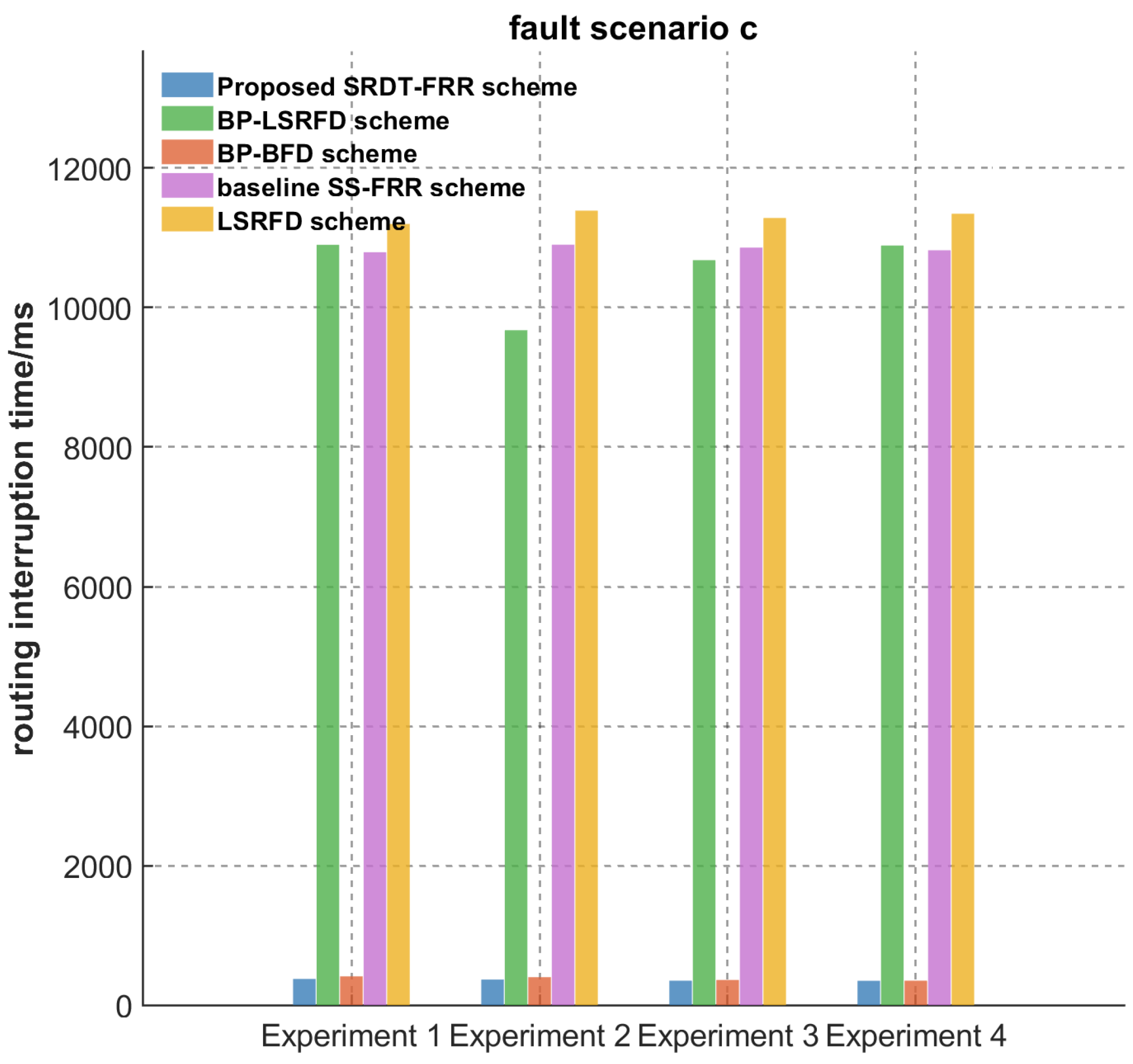
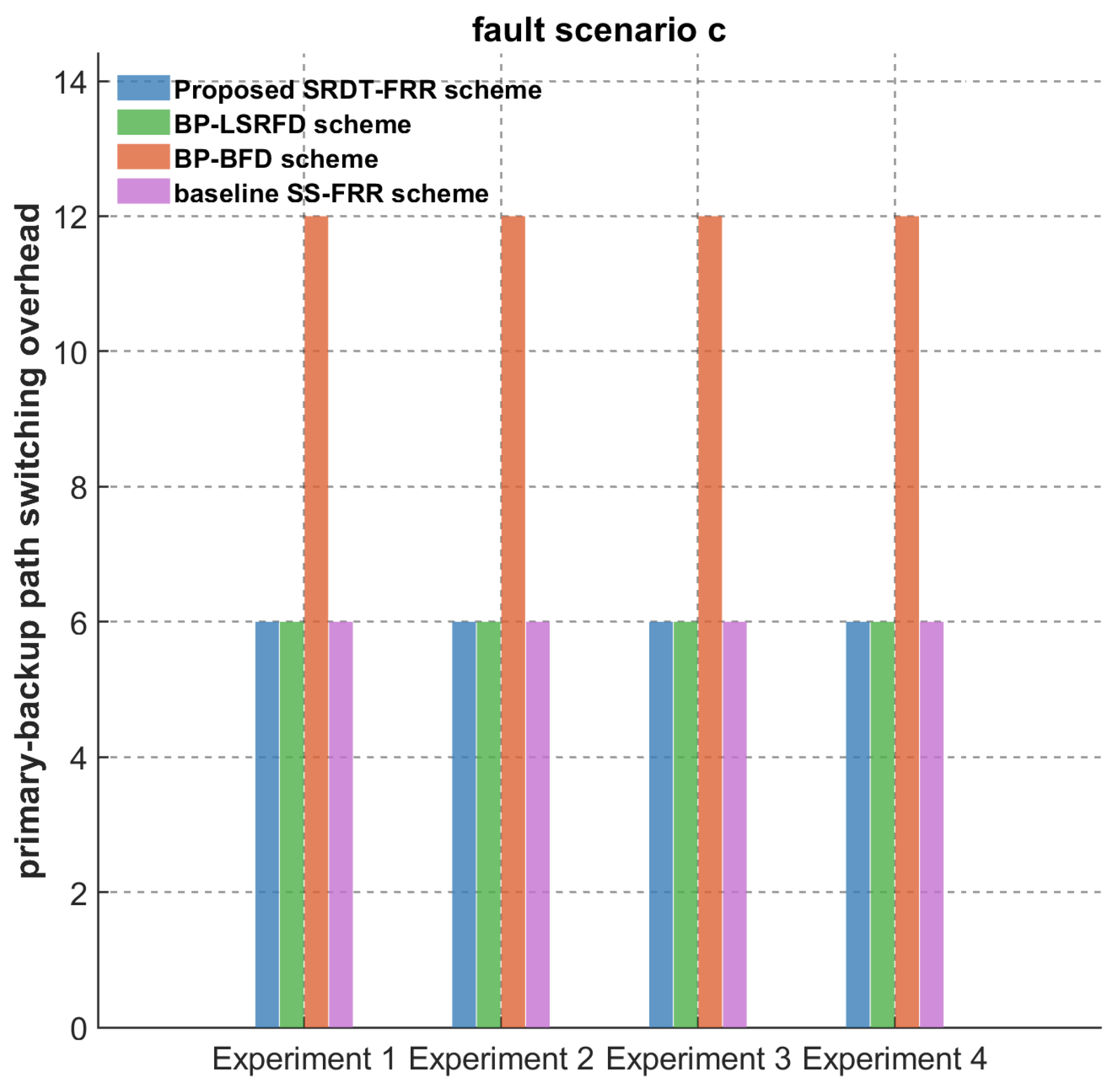

| FRR Methods | Experiment 1 | Experiment 2 | Experiment 3 | Experiment 4 |
|---|---|---|---|---|
| Proposed SRDT-FRR | 0.102033 | 0.109003 | 0.101162 | 0.100000 |
| BP-LSRFD | 0.969797 | 0.974443 | 0.944821 | 0.970958 |
| BP-BFD | 0.103485 | 0.109003 | 0.102904 | 0.102033 |
| baseline SS-FRR | 0.963117 | 0.969797 | 0.965150 | 0.967183 |
| LSRFD | 0.884608 | 0.890707 | 0.888093 | 0.900000 |
| FRR Methods | Mean | Standard Deviation | p-Value with Proposed SRDT-FRR |
|---|---|---|---|
| Proposed SRDT-FRR | 0.103050 | 0.003802 | / |
| BP-LSRFD | 0.964990 | 0.012056 | <0.001 |
| BP-BFD | 0.103485 | 0.109003 | >0.001 |
| baseline SS-FRR | 0.966312 | 0.002216 | <0.001 |
| LSRFD | 0.891602 | 0.005743 | <0.001 |
| FRR Methods | Experiment 1 | Experiment 2 | Experiment 3 | Experiment 4 |
|---|---|---|---|---|
| Proposed SRDT-FRR | 0.044111 | 0.125149 | 0.066666 | 0.035129 |
| BP-LSRFD | 0.763473 | 0.799401 | 0.806586 | 0.774251 |
| BP-BFD | 0.119760 | 0.134131 | 0.135928 | 0.114371 |
| baseline SS-FRR | 0.761676 | 0.78502 | 0.788622 | 0.752694 |
| LSRFD | 0.817365 | 0.892814 | 0.9 | 0.860479 |
| FRR Methods | Mean | Standard Deviation | p-Value with Proposed SRDT-FRR |
|---|---|---|---|
| Proposed SRDT-FRR | 0.067514 | 0.037451 | / |
| BP-LSRFD | 0.786478 | 0.011440 | <0.001 |
| BP-BFD | 0.126048 | 0.009074 | <0.001 |
| baseline SS-FRR | 0.757503 | 0.014663 | <0.001 |
| LSRFD | 0.868314 | 0.033472 | <0.001 |
| FRR Methods | Experiment 1 | Experiment 2 | Experiment 3 | Experiment 4 |
|---|---|---|---|---|
| Proposed SRDT-FRR | 0.052201 | 0.051386 | 0.050082 | 0.050000 |
| BP-LSRFD | 0.910058 | 0.810284 | 0.892125 | 0.909243 |
| BP-BFD | 0.105135 | 0.104157 | 0.100978 | 0.100082 |
| baseline SS-FRR | 0.901417 | 0.910221 | 0.906797 | 0.903618 |
| LSRFD | 0.884349 | 0.900000 | 0.891359 | 0.896332 |
| FRR Methods | Mean | Standard Deviation | p-Value with Proposed SRDT-FRR |
|---|---|---|---|
| Proposed SRDT-FRR | 0.051667 | 0.001188 | / |
| BP-LSRFD | 0.880935 | 0.039263 | <0.001 |
| BP-BFD | 0.102088 | 0.001720 | <0.001 |
| baseline SS-FRR | 0.902993 | 0.003356 | <0.001 |
| LSRFD | 0.894010 | 0.007390 | <0.001 |
Disclaimer/Publisher’s Note: The statements, opinions and data contained in all publications are solely those of the individual author(s) and contributor(s) and not of MDPI and/or the editor(s). MDPI and/or the editor(s) disclaim responsibility for any injury to people or property resulting from any ideas, methods, instructions or products referred to in the content. |
© 2025 by the authors. Licensee MDPI, Basel, Switzerland. This article is an open access article distributed under the terms and conditions of the Creative Commons Attribution (CC BY) license (https://creativecommons.org/licenses/by/4.0/).
Share and Cite
Du, J.; Zhang, R.; Hu, J.; Xia, T.; Liu, J. Fast Reroute Mechanism for Satellite Networks Based on Segment Routing and Dual Timers Switching. Aerospace 2025, 12, 233. https://doi.org/10.3390/aerospace12030233
Du J, Zhang R, Hu J, Xia T, Liu J. Fast Reroute Mechanism for Satellite Networks Based on Segment Routing and Dual Timers Switching. Aerospace. 2025; 12(3):233. https://doi.org/10.3390/aerospace12030233
Chicago/Turabian StyleDu, Jinyan, Ran Zhang, Jiangbo Hu, Tian Xia, and Jiang Liu. 2025. "Fast Reroute Mechanism for Satellite Networks Based on Segment Routing and Dual Timers Switching" Aerospace 12, no. 3: 233. https://doi.org/10.3390/aerospace12030233
APA StyleDu, J., Zhang, R., Hu, J., Xia, T., & Liu, J. (2025). Fast Reroute Mechanism for Satellite Networks Based on Segment Routing and Dual Timers Switching. Aerospace, 12(3), 233. https://doi.org/10.3390/aerospace12030233





